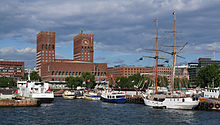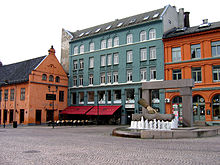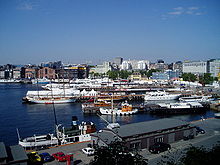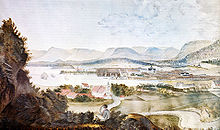Oslo
![]()
This article is about the capital of Norway. For other meanings, see Oslo (disambiguation).
![]()
Kristiania is a redirect to this article. See also: Kristianiaschwung or Christiania.
![]() (German: [ˈʔɔslo], Norwegian: [ˈʊʂlʊ], [ˈʊʃlʊ] or [ˈʊslʊ]) is the capital of the Kingdom of Norway. It also bore the name Christiania (1624 to 1924) or Kristiania (alternative spelling from 1877/1897 to 1924) in the past.
(German: [ˈʔɔslo], Norwegian: [ˈʊʂlʊ], [ˈʊʃlʊ] or [ˈʊslʊ]) is the capital of the Kingdom of Norway. It also bore the name Christiania (1624 to 1924) or Kristiania (alternative spelling from 1877/1897 to 1924) in the past.
The municipality of Oslo has 697,010 inhabitants (as of 1 January 2021). It forms an independent province (Fylke) and is also the administrative seat for the neighbouring province of Viken.
With 1,019,513 inhabitants, Oslo is by far the largest metropolitan area in the country. More than 1.5 million people live in the Greater Oslo region, almost a third of Norway's total population of around 5.3 million.
Place name
Both o's are - as in most words - pronounced like German u in Norwegian, i.e. [ˈʊʃlʊ] or [ˈʊslʊ]. The most common explanation derives the name Oslo from the river Alnaelva, which in earlier times was called Lo(en). Norwegian os is the mouth of the river. Compared to the numerous other estuaries such as Nidaros and Namsos, however, the word components river name and estuary are here interchanged, avoiding the coincidence of two identical vowels.
After a large town fire in 1624, the town was moved about a kilometre northwest under the Danish King Christian IV and renamed Christiania. In 1877, under the Swedish-Norwegian King Oskar II, the official spelling in the register and state calendar changed to Kristiania, while the city administration kept the original spelling until 1897. It was not until 1924, twenty years after Norway had gained its independence, that it was decided to return the city to its original name of Oslo on 1 January 1925, after some 300 years. The monumental Oslo City Hall, which took 35 years to build from 1915 (first architectural competition) to 1950, can be considered a symbolic building of the newly won independence.
Oslo was also called Tigerstaden (Tiger City) after a poem by Bjørnstjerne Bjørnson ("Sidste Sang", 1870), because he sees it as a dangerous and ruthless city. In front of the town hall and the railway station tiger sculptures remind of this name, which has lost its negative sound in the meantime. Also Knut Hamsun in Hunger (novel) from 1890, Norwegian and Danish "Sult", depicts the city according to his feelings in an extremely negative way.

Oslo harbour with city hall

Christiania Torv, on the square a sculpture by Wenche Gulbransen

View from the fortress Akershus to the quay Rådhusbrygga

Oslo, from the direction of Ekeberg (2005)
History
Prehistoric traces can be found in the rock carvings at Ekeberg.
In Heimskringla, a history of Norwegian kings, the Icelandic scholar Snorri Sturluson claims that Oslo was founded in 1048 by King Harald III. More recent excavations, however, have revealed Christian tombs dating back to around 1000. For this reason, the city celebrated its thousandth anniversary in 2000, whereas in 1950 it had only celebrated its 900th birthday.
The medieval town had two castles, the King's Court and the Bishop's Castle. Within the city walls there were nine churches, including St. Clement's and Hallvard's Cathedrals, a hospital and about 400 town houses of merchants and craftsmen. The dwellings were made of wood.
King Håkon V made Oslo the capital of Norway in 1299, ordered the construction of Akershus Fortress and saw to a number of other building activities such as the construction of St. Mary's Church. In the late Middle Ages, Oslo developed into an important merchant and residential city. The population doubled to 3,500.
In 1308, Oslo was sacked and burned down by Duke Erik av Södermanland. The still unfinished fortress of Akershus, however, survived the siege.
The town was repeatedly ravaged by fires, but was always rebuilt. After the Reformation, the monastery and most of the numerous churches fell into disrepair. After the fires, these buildings were demolished and the stones used for other building purposes. During the Swedish siege in 1537, the town burned again.
After the great fire of 1624, however, the town was not rebuilt, but moved closer to the fortress of Akershus on the orders of the Danish King Christian IV - Norway was a province of Denmark at that time.
The newly built city was constructed according to the ideal model of the Renaissance with rectangular quarters and wide streets and received a fortification with bastions. The houses were now built in stone or of masonry half-timbering to prevent the spread of fires. At the same time, the city was named Christiania, after King Christian IV.
Old Oslo now lay outside the walls of Christiania. Despite royal prohibition, it was repopulated, mainly by the poor and landless who could not afford the expensive life in modern Christiania.
The Johannes Kirke was built in 1875 and demolished in 1928.
Within the core city, there is an unusually high price level for Europe. In corresponding rankings based on standardized baskets of goods, the city regularly occupies top positions. According to The Economist, Oslo has replaced Tokyo as the world's most expensive city since 2006. Until then, the Japanese capital had occupied first place for 14 years.
The University of Oslo is the largest in the country, with about 30,000 students, and was founded in 1811 on the model of the Friedrich Wilhelm University in Berlin. In 1952, the Winter Olympics were held in Oslo, including at Holmenkollen.
In the early 1990s, the first secret negotiations between the PLO and Israel took place in Oslo under Norwegian mediation.
See also: Oslo Peace Process
On 22 July 2011, the assassin Anders Behring Breivik killed eight people in a bomb attack in the government quarter in Oslo. The assassin then shot a further 69 people on the island of Utøya.
See also: Attacks in Norway 2011

Christiania, view from the direction of Ekeberg (1814)

Commemoration of the victims of the attacks of 22 July 2011
_Panorama_fra_St._Hanshaugen_(1890-1900).jpg)
Panorama around 1895

Fjord à Christiania , painting by Claude Monet (1895).
Search within the encyclopedia